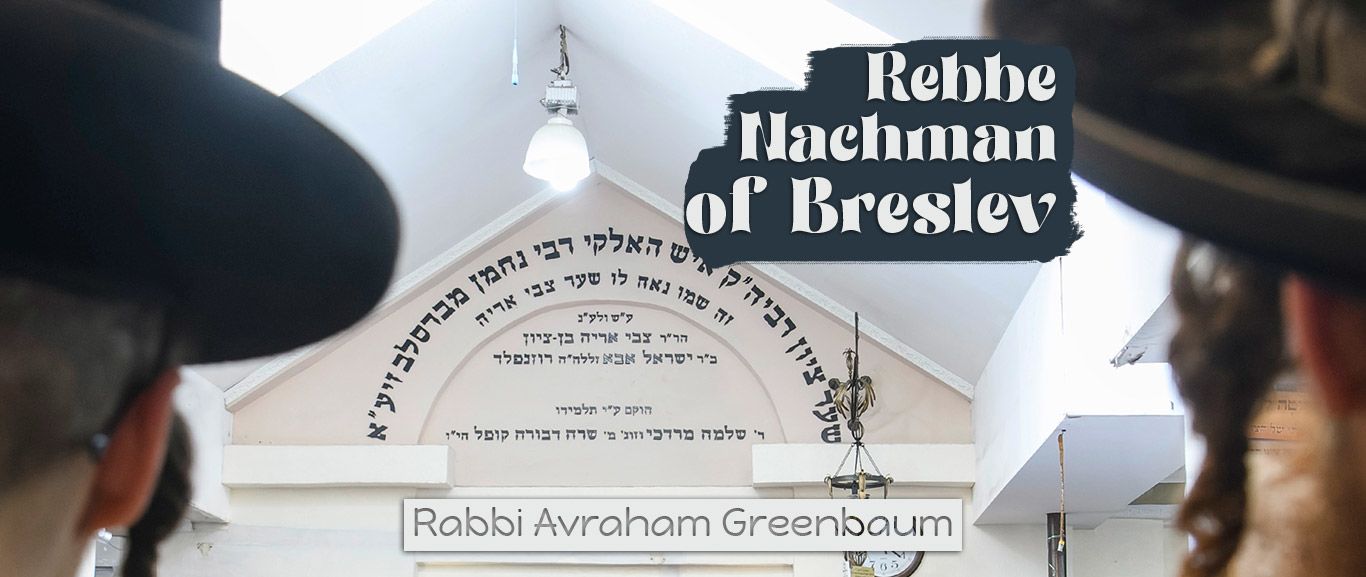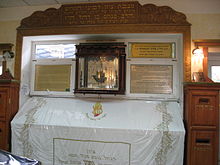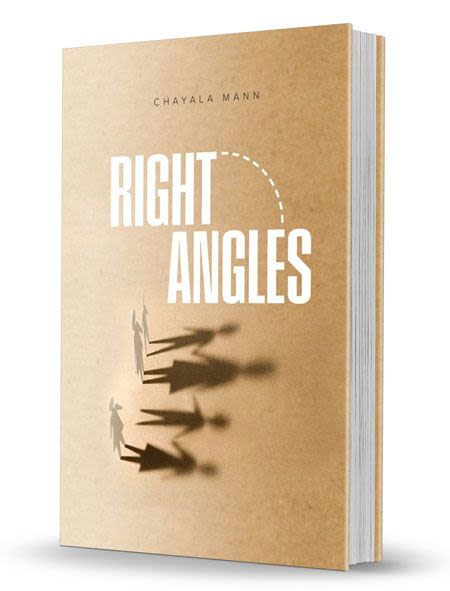He was the true “live man,” the like of whom there has never been. At all times he was truly alive. His life was always new life. There are countless gradations in the life and vitality found in the world. Real life is the life of true wisdom, and the essence of wisdom is to labor and endeavor to know and acknowledge God, Who is the Life of life. The closer one comes to God, the more one’s life is genuine life. The righteous are constantly attached to true life. But the life which the Rebbe himself achieved was on an altogether higher, more exalted plane, the like of which no man has ever tasted. Because the Rebbe had long life, the truly good life. (Chayey Moharan, Introduction)
Rabbi Nachman was born on 1 Nissan, 5532 (4 April 1772) in the Ukrainian town of Medzeboz, where his great-grandfather, Rabbi Israel, the Baal Shem Tov, founder of the Chassidic movement, had lived and was buried.
Rabbi Nachman’s father, Reb Simchah, was the son of Reb Nachman Horodenker, who had been one of the Baal Shem Tov’s closest disciples and a member of his household. Rabbi Nachman’s mother was Feiga, daughter of the Baal Shem Tov’s daughter, Odel. Rabbi Nachman asked that when invoking his merit people should refer to him as Nachman ben (son of) Feiga.
As a young boy he hid his devotions from everyone, performing long ablutions in the cold mikveh pool even in the heart of winter and secluding himself in the forests for lengthy periods of prayer and meditation in addition to prodigious study.
Marriage
In accordance with the custom of his time, he was married at the age of 13 soon after becoming Bar Mitzvah. His wife was Sashia, daughter of Rabbi Ephraim of Ossatin, a village near the town of Medvedevka . In their 22 years of marriage they had eight children, but four – including two sons – died in childhood. Four daughters survived, with known descendants until today.
From the time of his marriage Rabbi Nachman lived in Ossatin with his father-in-law, continuing his studies and devotions until he attained unique levels of sanctity and holy spirit as well as being fully conversant with the entire array of Biblical, Talmudic, Halachic, Midrashic, and Kabalistic literature. At first he was unknown to all except one disciple five years his senior, Reb Shimon ben Baer, who attached himself to him shortly after his marriage and became his lifelong follower.
At the age of 18 Rabbi Nachman left his father-in-law’s home to live in Medvedevka, where he spent the next ten years. It was there that his greatness first became revealed, and he rapidly gained an ardent following including some distinguished scholars and Kabbalists and the octogenarian Rabbi Yekutiel, the Maggid of Terhovitz, one of the senior leaders of the Chassidic movement. Rabbi Nachman emphasized faith, prayer and ever-renewed spiritual growth. Because of his practice of hearing the personal confessions of his adherents, they were originally known as the Viduynikers – Confessors.
Pilgrimage to Israel
It was from Medvedevka that Rabbi Nachman set forth on his pilgrimage to the land of Israel in the early summer of 1798 despite its being at the center of a major land and sea war between Britain and Turkey against the French. Rabbi Nachman’s 14-month trip was fraught with every possible obstacle and he was repeatedly in mortal danger, but he accomplished his goal of walking in the Holy Land. He visited the holy sites in the north, but apparently not Jerusalem. Despite his capture by pirates on his homeward journey, Rabbi Nachman returned safely to Medvedevka in summer 1799.
Soon afterwards he moved to the town of Zlatipolia, where he spent two years. It was then that the opposition he suffered for most of the rest of his life began in earnest under the leadership of Rabbi Leib, the Zeidah (Grandfather) of Shpola.
Breslev
In 1802 at the age of 30, Rabbi Nachman left Zlatipolia to settle in the town of Breslev, where he spent most of the remaining eight years of his life. On entering the town he said that his followers would always be known as the Breslever Chassidim, pointing out that the name BReSLeV has the same letters as LeV BaSaR, a “heart of flesh” (Ezekiel 36:26).
Very soon after his arrival Rabbi Nachman was joined by the 22-year-old Nathan – Nosson – Sternhartz from the nearby town of Nemirov. Reb Nosson became Rabbi Nachman’s closest follower and transcribed almost all his teachings. After Rabbi Nachman left the world, Reb Nosson established what has become the worldwide Breslev Chassidic movement. Rebbe Nachman said of Reb Nosson: “Were it not for Reb Nosson, not a single page of my teachings would have remained”.
In the eight years that followed this fateful encounter, Rabbi Nachman radiated fresh Torah with his every word and gesture – a Torah in which the sublime spiritual heights he attained were interwoven with events in the lives of his family and followers against the wider backdrop of the Russian Pale of Settlement and the growing plight of its Jewish population. Rabbi Nachman’s Torah discourses, conversations, stories, parables, and accompanying episodes in his life were faithfully recorded by Reb Nosson.
Rabbi Nachman had great hopes for his baby son Shlomo Ephraim born in spring 1805, but a year later in the summer of 1806 the baby died and Rabbi Nachman mourned him deeply. His loss prompted Rabbi Nachman to venture on a new path which found expression in the stories he now began to tell, later printed as Sipurey Maasiot (in English, Rebbe Nachman’s Stories).
Rabbi Nachman’s wife Sashia died in summer 1807. Not long afterwards he remarried but had no children with his second wife. During this period Rabbi Nachman contracted tuberculosis, and when he started coughing he predicted that this illness would eventually take his life.
In autumn 1807 he journeyed across war-torn Europe to Lemberg (Lvov), where he received medical treatment while pursuing other purposes known to him alone. Lemberg was becoming a center of the incipient assimilationist movement.
Returning from Lemberg to Breslev in 1808, Rabbi Nachman defied the growing waves of doubt, skepticism and rationalism to give ever greater emphasis to faith, simplicity, personal prayer, devotion and happiness.
Uman
In summer 1810 Rabbi Nachman made his final journey to the town of Uman, through which he had passed eight years earlier on his way to Breslev, and whose old Jewish cemetery he had chosen as his place of burial. This was the burial site of the martyrs who sanctified God’s Name in Uman in 1768 – less than four years before Rabbi Nachman’s birth – when tens of thousands of Jews who refused to betray their faith were slaughtered in the space of three days. Forty years later Uman had become a leading center of the assimilationist movement.
Rabbi Nachman spent five months in Uman, during which he had lengthy discussions with three leading proponents of assimilation, who held him in the highest regard. Despite his illness he celebrated Rosh Hashanah of 5571/1810 with several hundred followers. During the first day of the festival his situation deteriorated seriously and he coughed up large quantities of blood. Nevertheless, despite his great weakness, he gave his customary teaching on the second evening, speaking for many hours. This was his last lesson.
Eighteen days later on 18 Tishri 5571/16 October 1810 – fourth day of the festival of Succot – Rabbi Nachman departed this life and was buried in the old cemetery of Uman amidst the martyrs of the 1768 massacre.
Rabbi Nachman lives on until today in the fire of his teachings and the zeal of his followers to print and spread them. It was Reb Nosson who took the initiative to print Rabbi Nachman’s discourses (Likutey Moharan), stories (Sipurey Maasiot) and conversations (Sichot Haran and Chayey Moharan) as well as his own discourses and commentaries.
Reb Nosson initiated visits to Rabbi Nachman’s grave site and the annual Rosh Hashanah gathering of his followers, the Breslever Chassidim, in Uman, where he built a synagogue. Uman remained the main center of the Breslever Chassidim until after the First World War, when it shifted to Israel. From there, the movement has spread to become worldwide.
Rebbe Nachman’s holy grave site in Uman
Related Articles and Videos
To read more articles about Rebbe Nachman, click here.
Interested in videos about Rebbe Nachman? Click here.
***
Rabbi Avraham Greenbaum is the director of Azamra. “The Essential Rebbe Nachman” is available for purchase online here.












